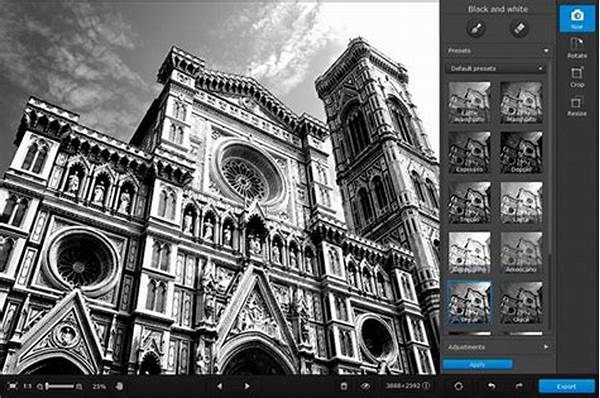Hey there, photography enthusiasts! Ever wondered why some photos just have that magnetic pull, making your eyes glide effortlessly through the image? That’s the magic of leading lines at work, my friends. In this guide to leading lines in photography, we’re going to dive into the world of these compelling compositional tools that can transform your shots from ordinary to breathtaking. So grab your camera and let’s get ready to unlock the power of leading lines!
Read Now : Camera Lenses For Profile Photography
Understanding Leading Lines
So, what’s the deal with leading lines? In the simplest terms, they’re elements within a photograph that guide the viewer’s eye along a path, ultimately drawing attention to a focal point or subject. Imagine a winding road, a line of trees, or even the edge of a building — these can all serve as fantastic leading lines. When you master the use of leading lines, you’ll notice that your photos start to communicate more clear and intentional messages, leading your audience on a journey through your composition.
Think of leading lines as the silent directors of your visual narrative. In this guide to leading lines in photography, we’ll explore how these lines can vary in style and direction — from horizontal to vertical, diagonal to converging. Each variation offers a different vibe and tells a unique story. Vertical lines can convey strength, while diagonal lines might inject some dynamism and movement into the shot. Learn to incorporate these into your frames, and watch as viewers get drawn into your work, savoring every detail with awe.
Types of Leading Lines
1. Natural Leading Lines: Nature’s got your back. Riverbanks, shorelines, and even scattered pebbles can form graceful lines that guide the viewer’s journey.
2. Architectural Leading Lines: Think stairways, fences, and city skylines. In urban settings, use structures to create breathtaking compositions.
3. Implied Lines: Sometimes, lines aren’t physical but rather suggested. A subject’s gaze or pointing finger can suggest a path for the eyes to follow.
4. Converging Lines: Create depth by using lines that converge toward a single point. Ideal for drawing attention to the center of your frame.
5. Curved Lines: These bring fluidity and grace, leading the eye in a gentle, often sensual progression through the photograph.
Capturing the Perfect Shot
Alright, let’s get practical. Start by scanning your scene for any existing lines. Trust me, they’re everywhere once you start looking with this guide to leading lines in photography. Position yourself so that these lines direct attention toward your subject or lead viewers on a delightful path through your image. It might take some time to perfect this, especially considering lighting, angles, and the overall composition, but don’t sweat. Practice makes perfect!
Also, don’t hesitate to get creative. Sometimes, refocusing attention on lines that aren’t immediately obvious can open new avenues. Whether it’s the shadow cast by an object or a line formed by contrasting colors, each element can add layers to your photograph. Play around, have fun, and keep shooting until you capture a frame that surprises even you.
Tips for Using Leading Lines
1. Scout Locations: Look around you. Street curbs, rivers, and even people in formation can serve as compelling lines.
2. Change Angles: Don’t be afraid to move! Changing your position can drastically change the scene’s leading lines.
3. Experiment with Depth: Use shallow depth of field to enhance focus, directing viewers with precision as per this guide to leading lines in photography.
4. Consider Symmetry: Symmetrical lines can create mesmerizing effects that hold a viewer’s curiosity.
5. Focus on Backgrounds: Sometimes, the backdrop can hold the leading line, enhancing the main subject’s impact.
Read Now : Wallet-friendly Online Photo Storage
6. Create Contrast: Use lines that contrast in tone from the surroundings for punchier images.
7. Utilize Negative Space: Allow breathing space around the leading line to emphasize its journey.
8. Follow the Light: Leverage natural light to enhance visibility of your chosen lines.
9. Context is Key: Ensure your lines enhance your subject’s narrative.
10. Practice & Patience: Keep experimenting—it’s the best way to see growth over time.
The Importance of Perspective
If you want your photos to narrate a compelling story, understanding perspective is your secret weapon. In your guide to leading lines in photography, the perspective from which you capture leading lines plays a crucial role in their effectiveness. Highlight this by adjusting your position relative to the lines. Crouch, tilt, or even climb if necessary to find that sweet spot.
Ingredients like leading lines demand a hefty serving of experimentation. Every shoot is a new game, so adopting different angles can radically alter the narrative and emotion of your image. And let’s not deny the thrill of moving gear around to hit the shot that just feels right. Plus, it’s a killer workout for those creative muscles!
A Slang Take on Leading Lines
Yo, picture this: you’re out snappin’ shots like a pro. Suddenly, bam! You spot that perfect zigzag in the crosswalk or the killer shadows from a skyscraper. That’s leading lines magic, dude. It’s all about showin’ the world where to look, kinda like a giant flashing arrow signaling your masterpiece. In this guide to leading lines in photography, remember that the real ones know it’s all in the lines, man.
Straight up, the wild part is how something as basic as a line can whip your pics into shape. It’s the artistic equivalent of herding cats, but way cooler. You’re out there getting creative, bending rules, and pretty much just lettin’ your shots do the talkin’. So, next time you’re out with your camera, just remember: lines ain’t just lines—they’re your trusty sidekick in turning thoughts into visual powerhouses.
Wrapping It Up
So there you have it, a full-fledged guide to leading lines in photography! Mastering these can skyrocket your photo game, making your shots standout material amidst the digital sea. Don’t rush the process—enjoy it. Photography isn’t just about snapping pictures; it’s an ongoing dialogue between you and the world around.
Each click of the shutter is a page in your visual diary, effortlessly pulling viewers along the narrative journey you’ve crafted with thoughtful leading lines. Don’t hesitate to experiment and let your creativity run wild. After all, photography is about exploration, discovery, and, most importantly, having a blast while doing it!
Ready to take your photography to the next level? Go out there, armed with this guide to leading lines in photography, and capture something amazing. Remember, your best shot is always just one click away!



